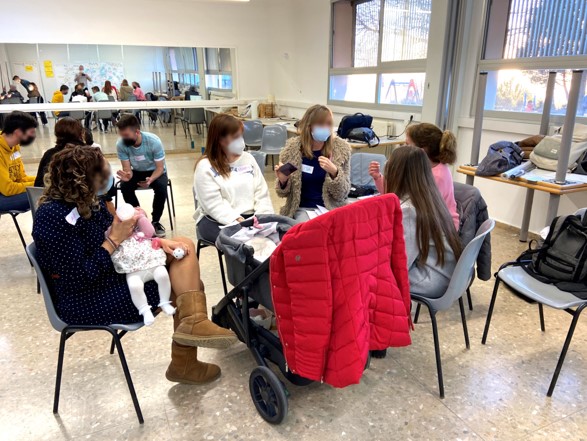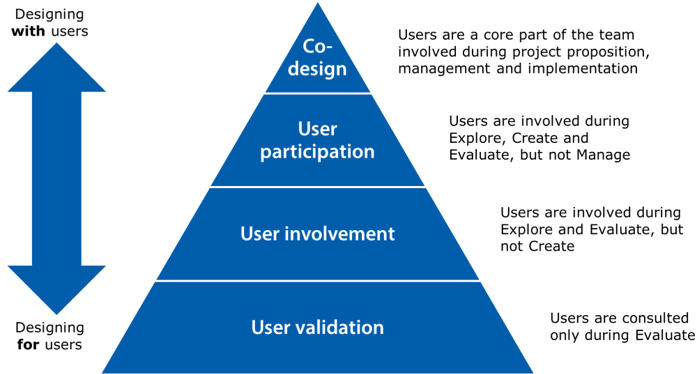Co-design is the term used to describe the direct engagement of end users and key stakeholders throughout the design process. This often includes a series of co-creation workshops, where the project team facilitate users and stakeholders to bring their experiences, knowledge and skill to better understand the problem and create solutions.
On this page:
Example of a co-creation workshop from one of the DIGNITY pilot projects (Find out more)
What is co-design?
There are different levels of engagement in a design process, from the lowest level of user validation, where user input is sought only to evaluate solutions in development, all the way through to co-design where users are strongly represented in the team and are setting the project direction (see Fig 1). Co-creation can occur in the top three levels, depending on the nature of the project and particularly the ambiguity of the proposition and user group.
Whilst more co-design is generally a very positive and productive approach to delivering inclusive solutions, caution must be exercised where the diversity of needs in the population of potential users cannot be accurately reflected in the team members representing those users. In these cases, the likelihood is that the solutions will reflect the needs of the users accurately represented, but may be inappropriate for users or scenarios which are not adequately represented in the team.
References
- Healey et al. (2014) Engagement through partnership: students as partners in learning and teaching in higher education. The Higher Education Academy
- Stark, et al. (2021) Coproduction with Autistic Adults: Reflections from the Authentic Research Collective
Principles of co-design
Co-design principles (Cruickshank et al., 2013):
- Agree how the success of the project will be recognised
- Move in and beyond your normal design practice
- Ethical considerations are important. See the page about ethics for more detail.
- Involve and respect lots of people in the ideas generating parts of the process
- Use the expertise of all participants in the process
- Let everyone be creative in their own way
- Explore and challenge assumptions
- Expect to go beyond the average
- Bring the process to the best possible conclusion with the best possible design outcome
Strengths and weaknesses of co-design
Co-design offers the opportunity for solutions to be grounded in the lived experience of real users, potentially addressing nuances of needs that would otherwise be unfulfilled. Where users are important stakeholders this is particularly valuable to the project success, as those involved in the design of solutions tend to have more ownership and be much more engaged as project advocates.
However, where representation of the variety of types of user groups in the co-design process cannot be complete or balanced, then it is likely that the solutions will be biased to reflect the needs of the users engaged in the process. Thus, recognising this skew in the light of the full range of user characteristics is likely to be needed, and explicitly compensated for, in the review of outputs.
Co-design events should be scheduled at a point when the team has sufficient time and resources to implement changes to the project proposition from the generated insights and ideas. .
What is a co-creation workshop
A co-creation workshop is a mechanism by which users are invited to a particular event (or in a series of events) where the facilitators will have prepared a way for the users to understand a particular problem area, and then for them to be able to contribute their ideas to solve it. It brings together users' personal lived-experience knowledge and perspective to bear on the issue, and often brings about ideas and solutions which the project team working in isolation would not have contemplated. However, the project team typically will find that they also have gained a much deeper understanding of the problem through having engaged in co-creation workshops with users.
Co-creation workshops (as opposed to exploratory focus groups or interviews), tend to be deployed when the project team have some focus on the area of problem that they will address, but are still open to learning more about it and refocusing with the benefits of further insights. The problem area needs to be articulable by the project team in a form that the users engaged in the co-creation workshops can understand and relate to.
In person workshops are more easily accessible to users who are digitally excluded and allow physical collaboration on materials such as idea boards. However, other factors may make in-person workshops difficult or even impossible for some potential participants. Depending on the accessibility needs of the attendees, it may be necessary to create separate materials for some individuals.
If in-person workshops are not possible, then virtual (online) workshops can be held. However, care needs to be taken to ensure that they are accessible to a wide range of participants and do not overtire participants (some of whom may not be used to virtual meetings).
Furthermore, it is vital that ideas are still elicited from digitally excluded groups who may not be willing to participate in an online workshops. These groups include those who have access to the internet but find it difficult to use unfamiliar technology. Some possible ways of involving digitally excluded users include sending out packs with creative prompts, questions for them to answer, and places for them to add their own ideas and suggestions. These need to have very clear instructions. Participants could complete them on their own and send them back and/or be interviewed over the telephone about their ideas.
How to run a co-creation workshop
It can be helpful to start a co-creation workshop with some kind of ice-breaking activity to introduce participants to each other and help them to relax. These activities should help participants to feel more comfortable speaking up in the group, and so should encourage participation from everyone and be easy for everyone to engage in.
It can then be helpful to introduce the context of the project. Participants may know little about the problem area of interest, so this introduction needs to cover any background they need to make informed suggestions. However, it should not be lengthy or technical as this is likely to reduce levels of engagement. Ideally, it should be presented in short chunks throughout the workshop, interspersed with interactive activities, rather than in one big section.
The main focus of the session should be on the participants generating ideas which have potential to address or partly address the problem/s identified in the explore phase . The exact nature of this activity will be guided by the nature of the particular project goal and the user groups affected.
There are a variety of activities that can help with this. IDEO lists some of these on their Design Kit (see link below), together with more detailed information about how to put them into practice. Some examples include: Conversation Starters, a Brainstorm, Role Plays, Rapid Prototyping. There are various websites and other resources to support you in setting up a co-creation workshop. Here are just a few examples:
- The Design Kit produced by IDEO gives some general advice on running a co-creation session together with links to more information about different prompts you can use within a session:
- An article from Futurice lists some of the things to consider when setting up a co-creation workshop remotely:
- A blog article from Leanne Fischer describes an example of a co-design kit used with older adults:
- An example of a co-creation workshop carried out on digital service ideas within a bus transport context:
Co-creation workshop checklist
- What is the scenario, context, topic and problem to be addressed?
- Which user groups will be invited? Are there special needs that must be accommodated? Will participants need to be incentivised to attend?
- Is the nature of the topic and user groups amenable to this workshop, or are other methods better?
- Who will run the event? (e.g. a professional facilitator, or team member)
- Where and when will the event take place? Will it be easy for the user groups to attend?
- How will the participants be introduced to the topic so they can engage appropriately? (e.g. briefing presentation, video showing a scenario, props on hand relevant to the topic)
- How will the output (ideas, concepts etc) be recorded? (e.g. using ideas and concepts sheets)
- How will the final concept(s) be selected? (e.g. using stickers for attendees to vote on concepts)
Feedback
We would welcome your feedback on this page:
Privacy policy. If your feedback comments warrant follow-up communication, we will send you an email using the details you have provided. Feedback comments are anonymized and then stored on our file server. If you select the option to receive or contribute to the news bulletin, we will store your name and email address on our file server for the purposes of managing your subscription. You can unsubscribe and have your details deleted at any time, by using our Unsubscribe form. If you select the option to receive an activation code, we will store your name and email address on our fileserver indefinitely. This information will only be used to contact you for the specific purpose that you have indicated; it will not be shared. We use this personal information with your consent, which you can withdraw at any time.
Read more about how we use your personal data. Any e-mails that are sent or received are stored on our mail server for up to 24 months.



